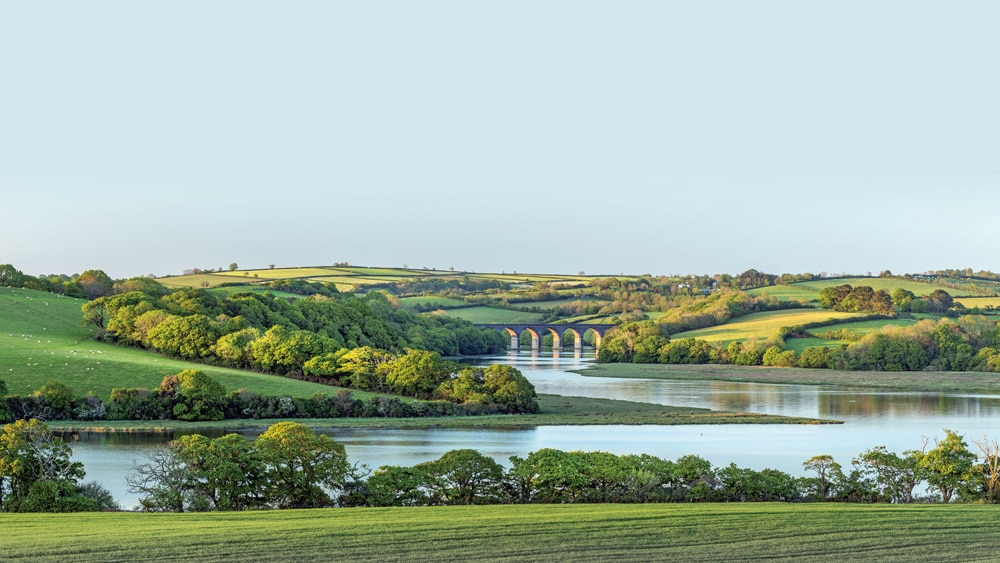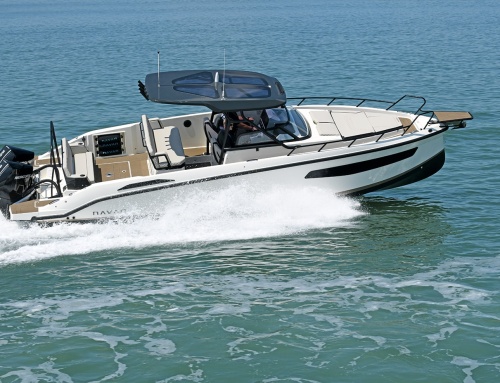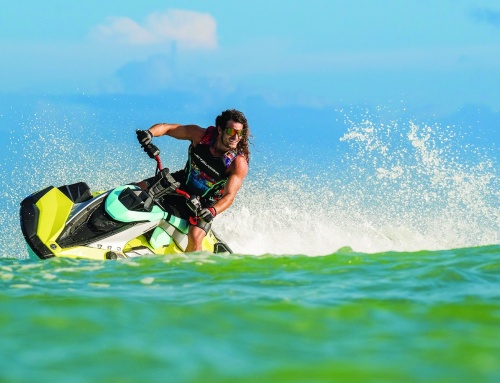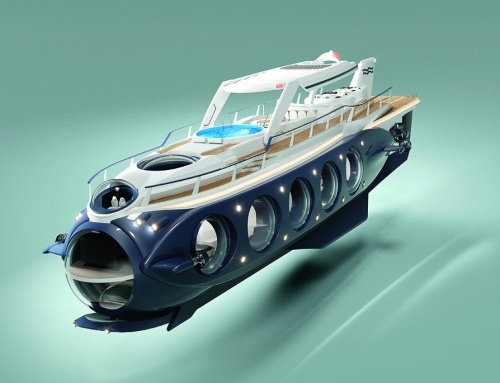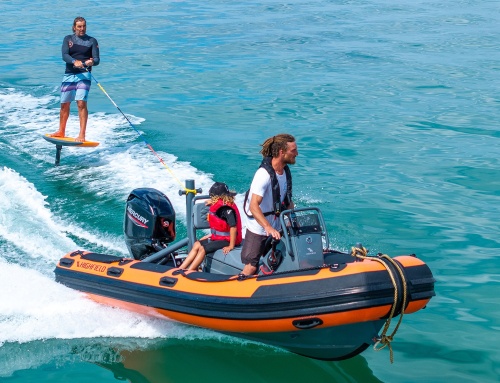PBR reader Phil Dargavel and his wife Jules are ardent adherents to the cause of trailer boating. Learn how the ‘open road’ is proving to be their gateway to adventure and an ‘ocean’ of possibilities …
Two years ago, Jules and I encountered a couple of red and white posts that I simply didn’t recognise far down a river. With a falling tide, we had a decision to make – which side should we go? We regretted our choice almost immediately! I’ll come back to how we got ourselves out of this muddy pickle a little later.
Like so many of us, my love of boating started with a modest sailing dinghy – a Gremlin, a kind of precursor to the Cadet and Mirror. It got my older brother and me afloat for holidays and we progressed to racing a Heron. It was far from state of the art, but OK for the cold winter racing we endured on Ruislip Lido a lifetime ago. We were pretty good too, usually coming in the top five, although this was down to my bro being a handy skipper and me being the willing but seemingly always dripping wet crew. It was so very cold – no modern-day clothes, just cable knit jumpers and anything else that would hold water until we got back to the clubhouse.
However, if we capsized and needed the rescue boat, I was actually pretty happy, while my bro seethed. You see, the rescue boat – a ropey old catamaran cobbled together in the DIY spirit of post-WW2 – was driven by a big Evinrude and the guys back then would sometimes let me have a go, which I loved, and I knew from an early age that power really had the edge for me. I think Dad knew this, which is why he bought a British Seagull outboard to drop on the Heron’s stern for me to pilot up the Thames occasionally. It certainly couldn’t be described as ‘raw power’, but I loved those trips and knew I’d have something ‘proper’ one day.
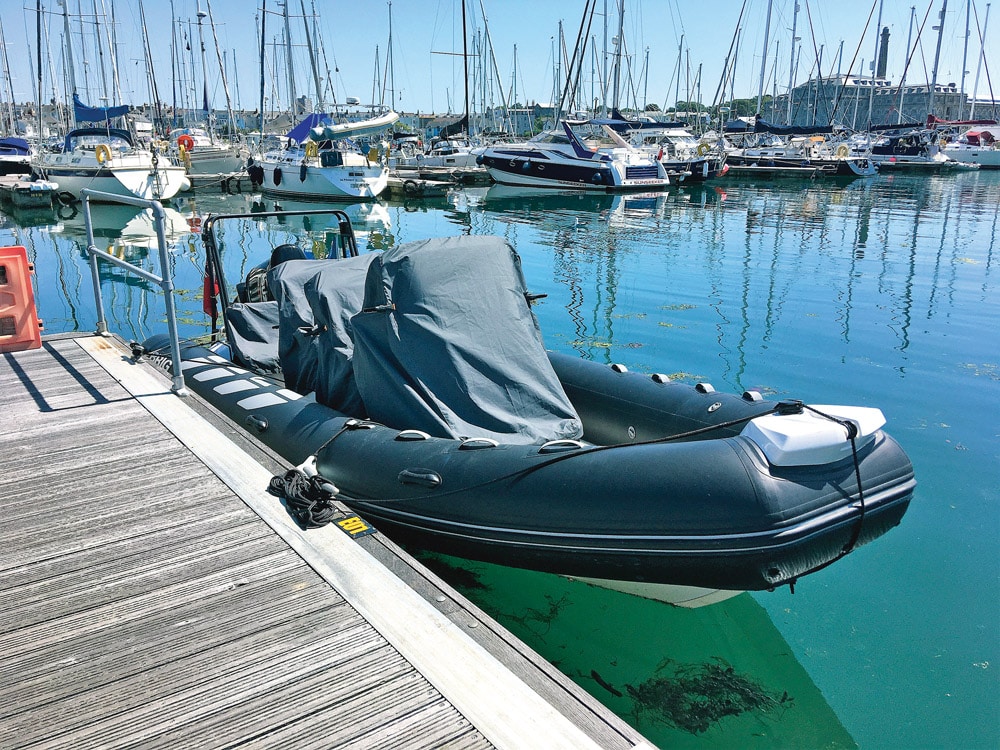
Hurricane on her berth.
Powering up
Fast-forward 40 years and I had a mortgage, children and various jobs, sometimes in the marine industry, with redundancy propelling me into something else completely. But I finally landed on our first day boat – a Bombard Explorer 500 with a Mercury 60hp sitting on its own trailer.
I always knew she would not be kept afloat, and as our home was in Christchurch just a stone’s throw from a handy slip, she lived on our driveway. Plus, not being particularly heavy, launching was a cinch, and we would often go to the Beach Hut (as it was) by the posh huts at Mudeford for a breakfast before shooting out somewhere, maybe west to Poole or east to Yarmouth.
Not afraid to trail, we took her to Falmouth a couple of times and would also pop her in at various points around the south coast. We realised our boating horizons could simply be as far as we were prepared to go!
But 5 metres has its limitations when out on the water, and a change in the weather can transform the sea quickly, as we all know, and spoil the day. This RIB had been huge fun over the five years we kept her, but it was time to trade up, and 6m+ was what we decided on – even better for the short chop of the Solent and good enough for the kind of weather we would be happy to go out in, but most importantly, still manageable to trail, launch and recover!
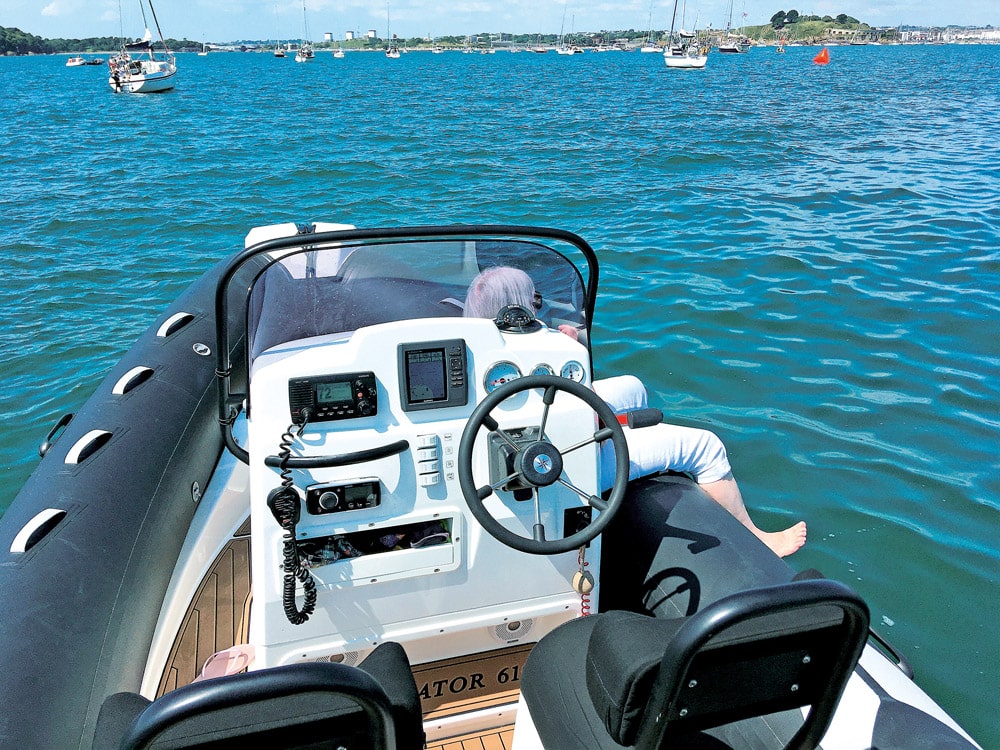
Taking in the view.
We went for a BRIG Navigator 610 and signed at the Southampton Boat Show some years back. It was a great day and came on the back of my son and I completing our PB2 and also an RYA Instructor course. While we had some great plans to put the instructor qualification to good use, life got in the way. At the very least, though, the exercise was immensely valuable and certainly improved our approach to boating.
Hurricane force
The BRIG has been simply fantastic. We call her Hurricane, and with a Suzuki 140 on the back she does everything we ask of her. She is confidence inspiring when the going gets tough, comfortable enough to lounge on for an afternoon at anchor, and safe enough to take the grandkids out and become a family boat.
However, it quickly became apparent that she was too big to keep on the drive and launch on a whim, so we decided to put her in a dry stack. We found just what we needed in Southampton, which is only a 40-minute drive for us – about how long it took for them to get Hurricane launched by the time we arrived. With the trailer not in use, they were happy to store it and gently put Hurricane back on if we were off somewhere different.
Being up the River Itchen would give us 20 minutes to get to Southampton Water and figure out where we might go – usually for lunch. There were so many options and plenty of cruise ships to chase out on some days too. It’s a great area and also perfectly placed for our kids to use the boat when they fancy.
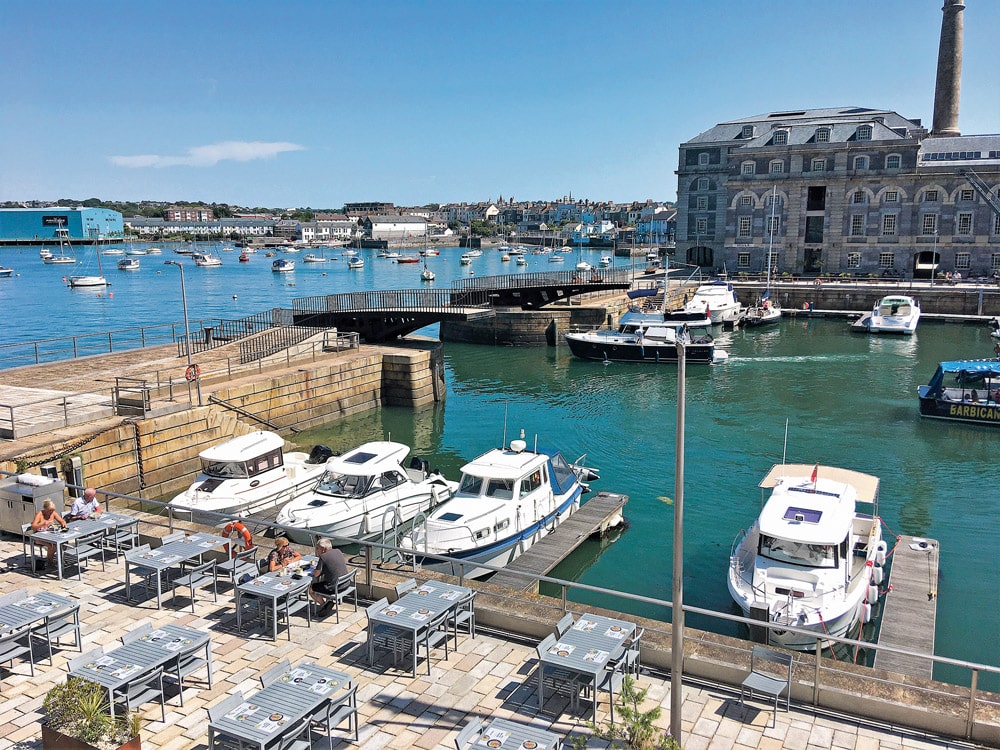
Royal William Yard, Plymouth
We’ve had our fair share of adventures on the Solent, but trailering the boat out of the area brings its own sense of adventure. One of these was to follow the SailGP race series to Plymouth back in 2021. It was the third season for these hybrid catamarans, which can top out at 70kph (37 knots) and are somewhat faster than Hurricane even when she’s at full chat. To see them in the flesh rather than on YouTube would be super-exciting, so the planning started. I didn’t know much about Plymouth at that point, so it was a fun learning curve figuring out where best to launch, moor and stay for the duration. The SailGP village was to be at the National Marine Park, so we knew we should avoid that area.
But hidden around the corner is Royal William Yard, originally built for the Royal Navy as a victualling yard in the mid-1830s and used to supply HM ships right up to 1992 when the Royal Navy withdrew. The government of the day created the Plymouth Development Corporation to regenerate the area in terms of leisure, living, shopping and tourism. They’ve done a great job and it’s even got the smallest of marinas. Perfect!
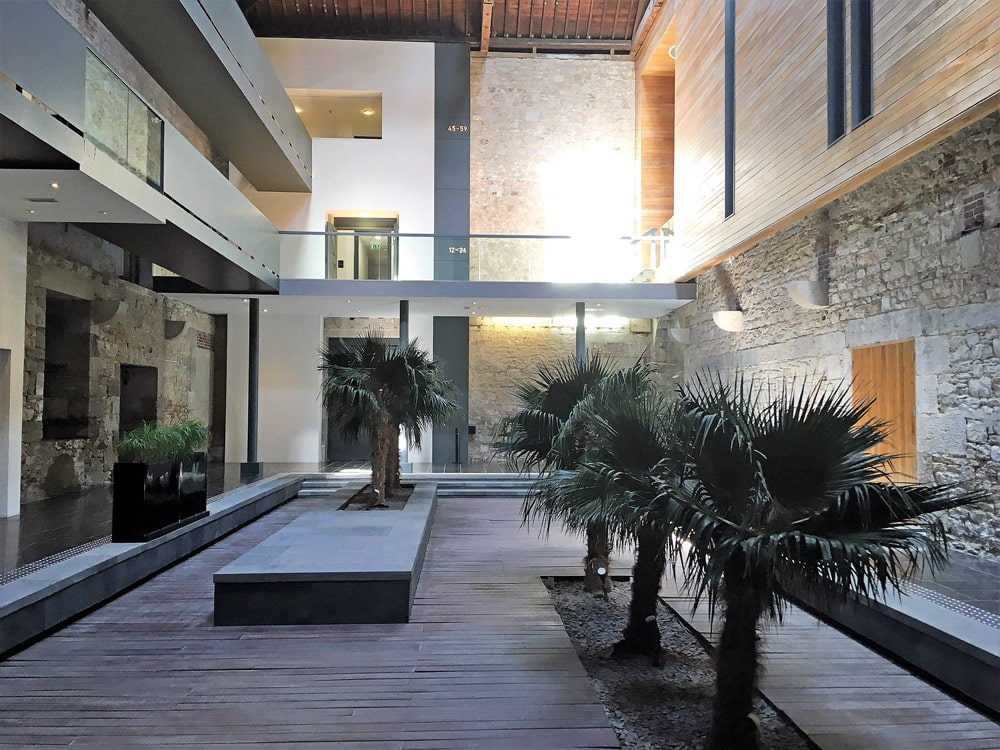
Swish interior.
Well, not quite. The marina simply didn’t have the room for visitors, especially when things were filling up quickly with the SailGP circus coming to town. ‘Try Mayflower Marina,’ they said, which I did, and Mayflower were happy to help and promised to squeeze us in somewhere, which was good enough for me.
Meanwhile, back to Royal William Yard. They have some fabulous apartments to rent there, so I booked straight away to make sure we had somewhere to stay – plus, it’s only a 10-minute walk to Mayflower Marina, so we would hardly need the car. So far, so good. Moreover, there was a handy public slipway next to Mayflower Marina. This plan was coming together well.
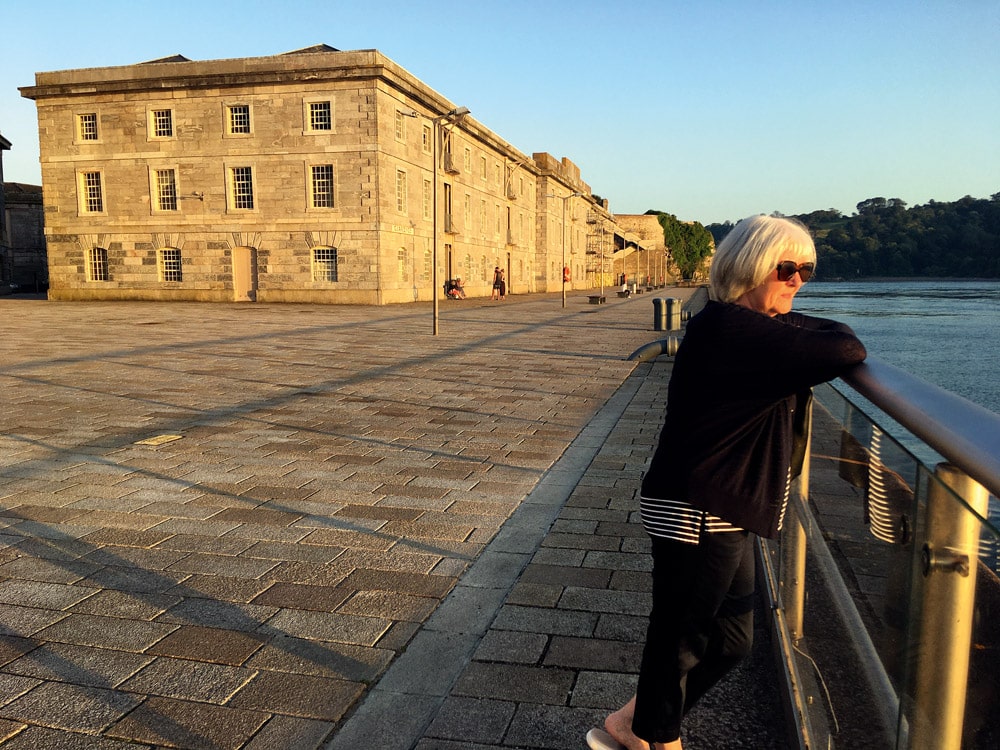
Jules enjoying the sunset.
We still had a few months to fine-tune things before leaving from Christchurch, which gave us a chance to look at places to go and things to do. As it turns out, there’s plenty, but what would the weather be like? Well, luckily for us, a high was sitting over the UK that bathed most of the country in sunshine and gentle breezes. It really couldn’t have been better!
Heading west
It’s about a three-hour journey trailing the boat to Plymouth, and finding our way to Mayflower Marina was straightforward enough with the slipway just beyond by Blagdon’s Boatyard. We arrived a day before the race weekend in the hope of missing the crowds, and this worked well for us. The slip is straightforward enough and, once launched, I put Hurricane onto her assigned berth and moved the trailer to the spot where she would be stored for our stay. Then we were off to King William Yard to book into our apartment.
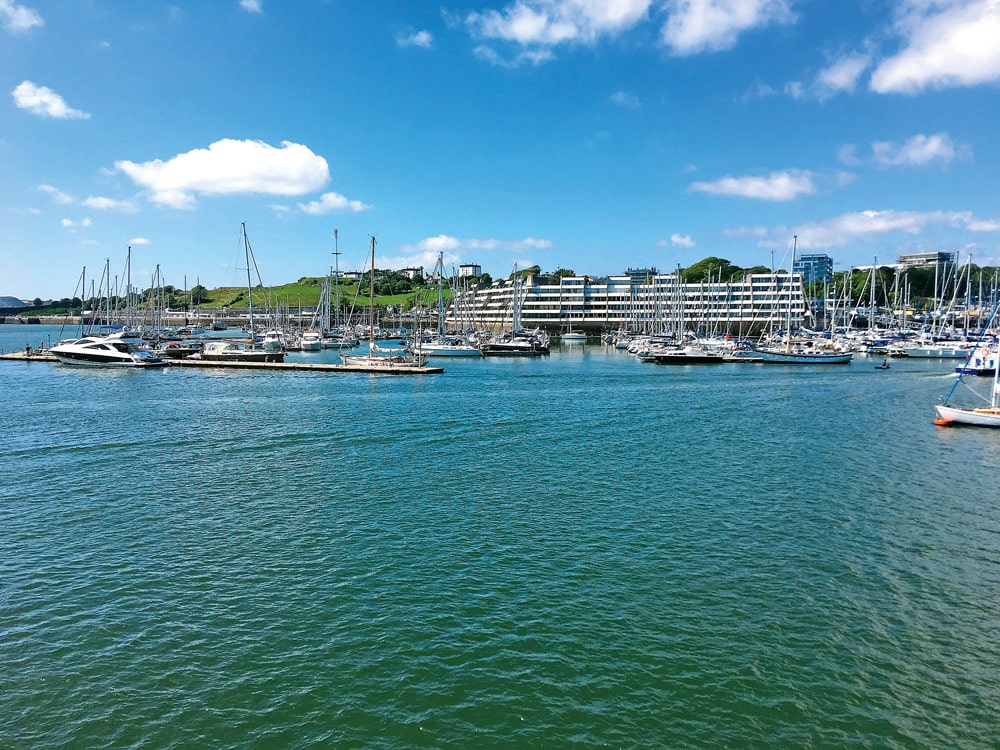
Mayflower marina Plymouth
Well, what a find! The buildings have retained their 19th-century heritage, but the apartment was bang up to date and, even better, looking out over its own marina and also Mayflower. With plenty of eateries downstairs, we didn’t hang around and sped off to grab a drink and some food. It had been quite a day, and this was just the start!
We sandwiched the weekend of actual SailGP racing with trips out either side. Just exploring the waters around Plymouth was an adventure as it was new for us. We learned about ‘the bridge’ west of Drake Island – either side could cost us a prop. This island, though achingly tempting to moor on, is a no-no, as is the breakwater. But the landscape and the Hoe are glorious, and even the brutal and more industrial stuff further up the Hamoaze is a stark reminder of what HM Navy does.
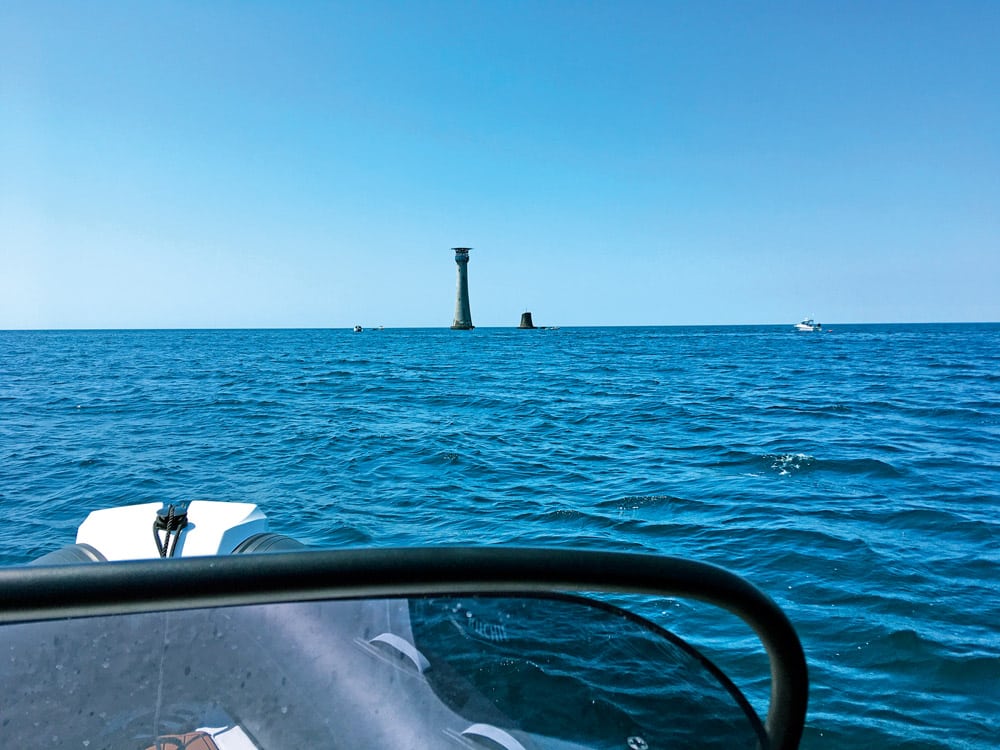
Approaching the Eddystone Lighthouse.
So a trip offshore was one of our first adventures, out to the Eddystone Lighthouse – not too far and the sea was sublime, although we passed some crazy paddleboarders about 5 miles out. The current lighthouse first appears as a speck but is slowly drawn in with the stump of Smeaton’s third tower alongside. It was great just spending an hour or so bobbing around and drinking in the history of the lighthouses past and present while fishing boats passed by, tourist boats stopped for a peak, and other RIBs came and went. The wind picked up on the way back, but it was still a cracking journey!
SailGP was racing the next day and we figured out where we would watch – just north of the breakwater. The sun was on its way up when we left that morning and the SailGP boats were out fine-tuning their rigs, which make a really strange ringing noise when they are up on their foils – weird yet majestic, and very fast.
Rather than dropping anchor to spectate, we kept on the move, slowly running along the length of the breakwater to keep a track of these super-fast boats as they rocketed around that day’s course. It was well marshalled, which we found out when venturing over an imaginary line where we were politely asked to move back.
Racing went on for a couple of days. Each event only lasted around 15 minutes, which was perfect, as we had plenty of time to go off and explore. For a change of pace, we wanted to go up the River Tamar at least as far as Calstock and maybe Morwellham Quay. It was a rising tide, so it seemed the perfect idea.
Up the creek!
Heading north back past Mayflower Marina, things open up as you enter the Hamoaze with the Royal Shipyards lining the eastern shore. There were quite a few submarines, which was new to us as it tends to be surface ships in and out of the Solent. Then, once past the entrance to the River Lynher, we went under Brunel’s Royal Albert Bridge and then the Tamar Bridge. We’ve been over that one so many times, but its size from the water is something else!

Royal Albert Bridge & Tamar Suspension Bridge crossing the River Tamar between Plymouth and Saltash.
Carrying on, the buzz of Plymouth disappeared and the sun blazed down on these tranquil waters. It really was a lovely dawdle up to Calstock, passing historic quays on the way, including the pretty Cotehele Quay with its beautiful medieval manor house of the same name, set high among the woods above the riverbank. The steep 20-minute walk up the woodland path to the house is well worth the effort as this ancient house and grounds, now in the care of the National Trust, are one of the rarest and most unique examples of medieval and Tudor architecture in Britain. But there was no time to stop on this occasion to explore ashore sadly, as we wanted to press on until heaving to under the impressive Calstock viaduct and its towering arches. We picked up a mooring mid-river, put the parasol up and enjoyed a sandwich and beer on board just as a colossal tourist boat steamed up alongside on its way to the town quay. Didn’t see that one coming up behind us!
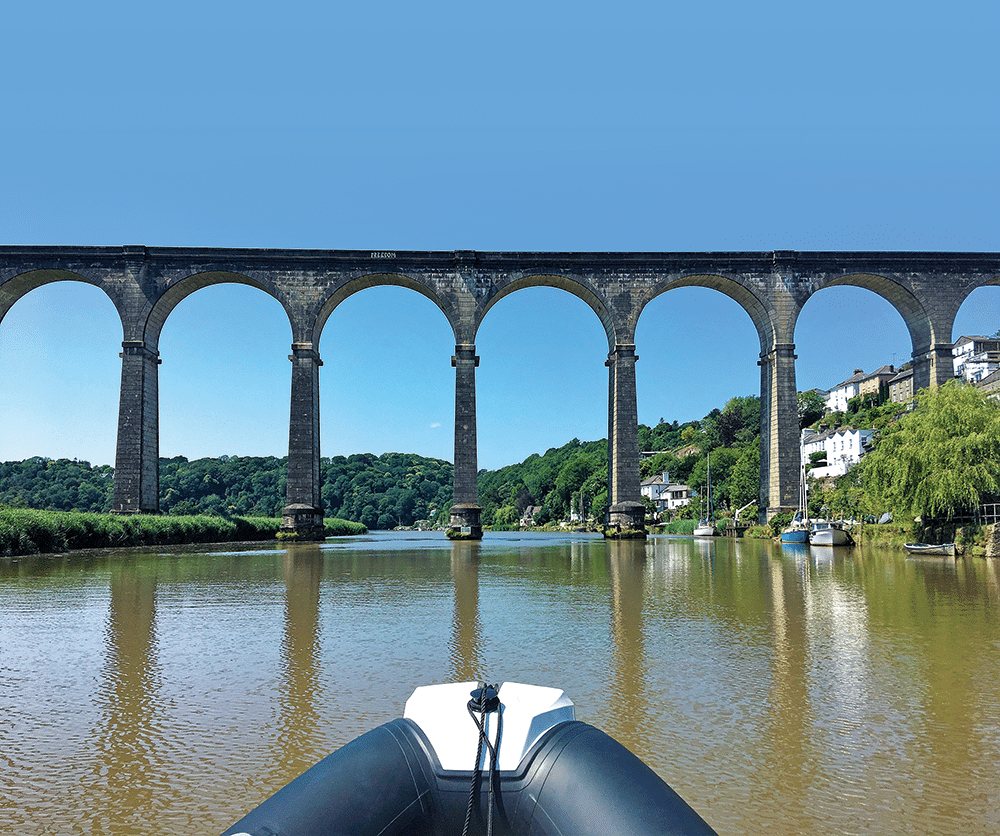
The Calstock Viaduct.
After a laze and our welcome vittles break, we pressed on to Morwellham Quay, which was truly delightful, abounding with history and old-world charm. But it was tricky to moor up here as we were in need of extra-long warps to reach the old Victorian iron bollards that were set so far back on the quayside. Staying aboard the boat suited us, though, as we soaked up the scene afloat while the river gently ebbed beneath our hull and we contemplated our return voyage back to Plymouth.
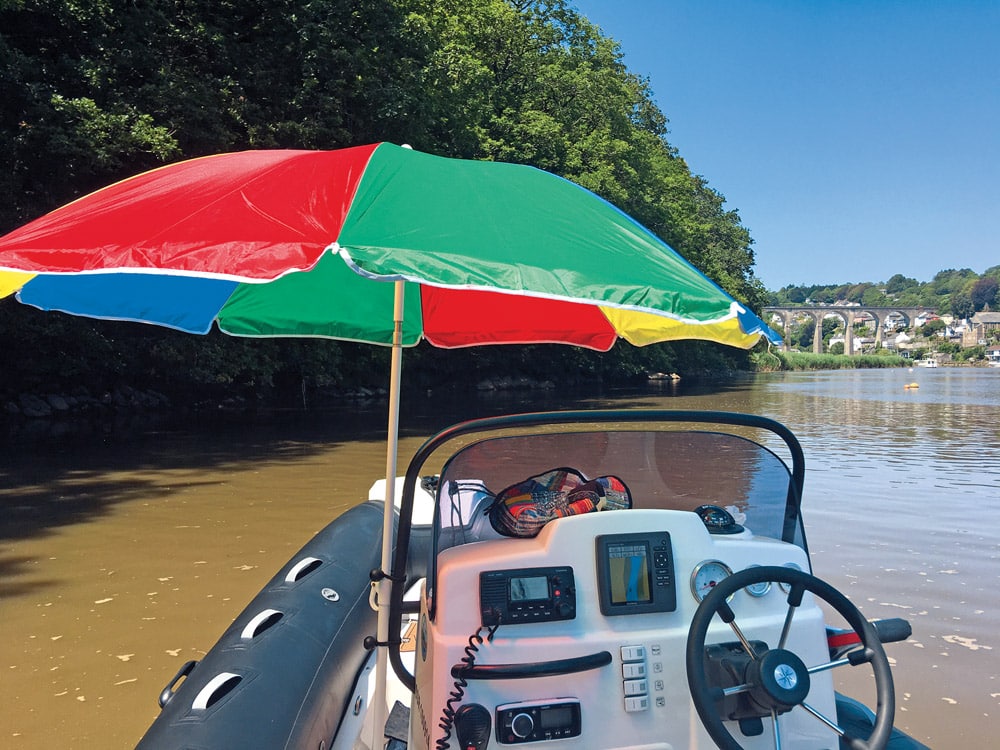
Enjoying lunch on the Tamar at Calstock.

Cotehele House (©HMS)
The tide had been ebbing for a couple of hours, in fact, but I reckoned we had time to divert up the River Lynher and aim for St Germans. I’m guessing any locals reading this may already be grinning … It took less than an hour to get back to the river entrance and we started our journey up, passing a couple of anchored RN ships and following the various poles marking the route. It was all going rather well until we arrived at the point where the Lynher splits with the Tiddy, which we were aiming for … and the red and white posts.
The markings were horizontal, I thought, which threw me, and I elected to go between them, hoping they signalled safe water. But no – they were in fact red and white vertical marks! While we weren’t going more than about 4 knots, we had enough way on to slide irritatingly onto a sticky mudbank, where we came to a halt. Engine off and up, I grabbed the boathook to see what the mud was like, but it was so very soft there was no way I could jump off and heroically push us back. I’d disappear!
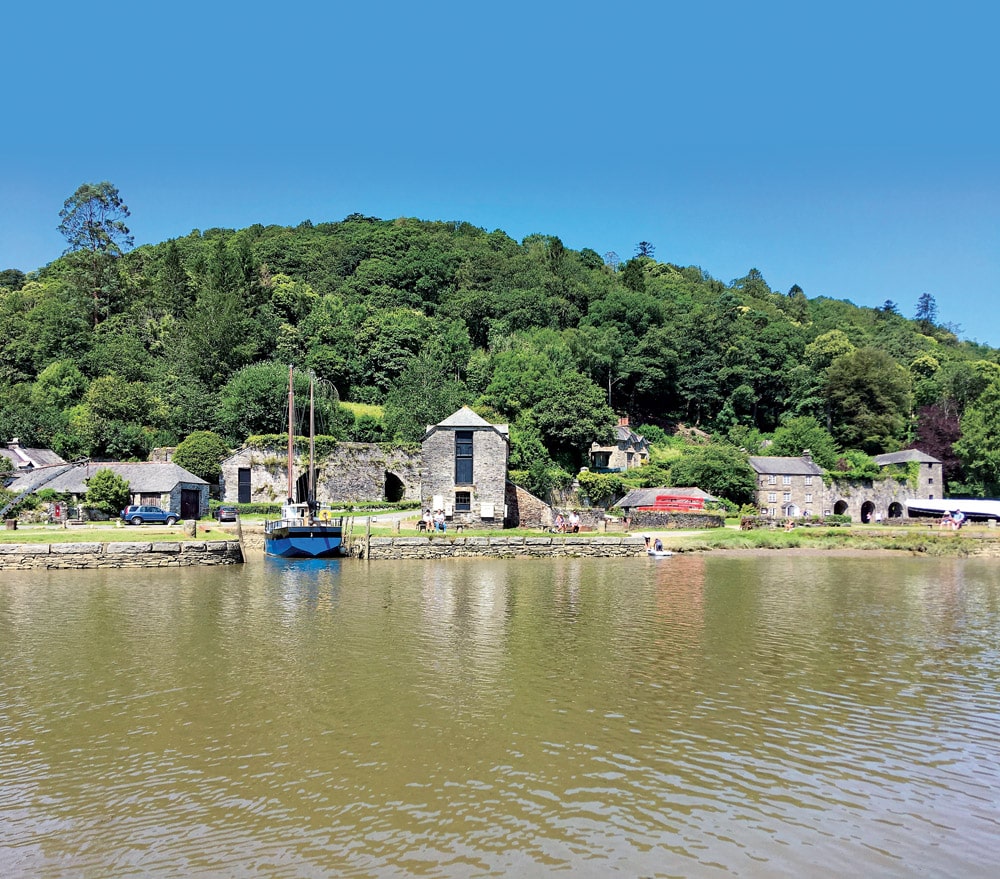
Cotehele Quay.
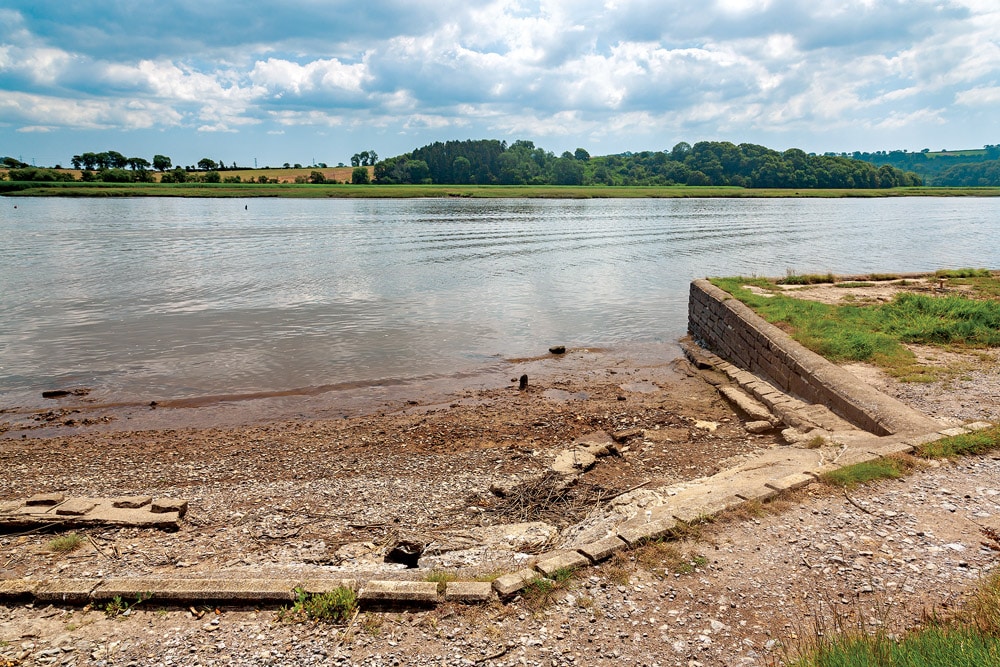
Halton Quay. © Ian Woolcock istock.
There was not another soul on the river to hail for help, and it would be hours before a rising tide could float us off. But then I had a light bulb moment. I can’t remember where I had seen this trick before, but I had to give it a go. The idea was to get the anchor and warp to the stern of the boat and lob it as far as possible behind us and then pull ourselves off. Our anchor has 6 metres of chain before the warp, which made it a tangled mess to throw. But Jules held a length of it, making sure the warp was free to follow, and I threw as best I could. It was far from graceful, but when it had settled, I pulled on the warp and Hurricane started to slip back into the channel. I couldn’t believe it, but we were afloat again – with mud everywhere.
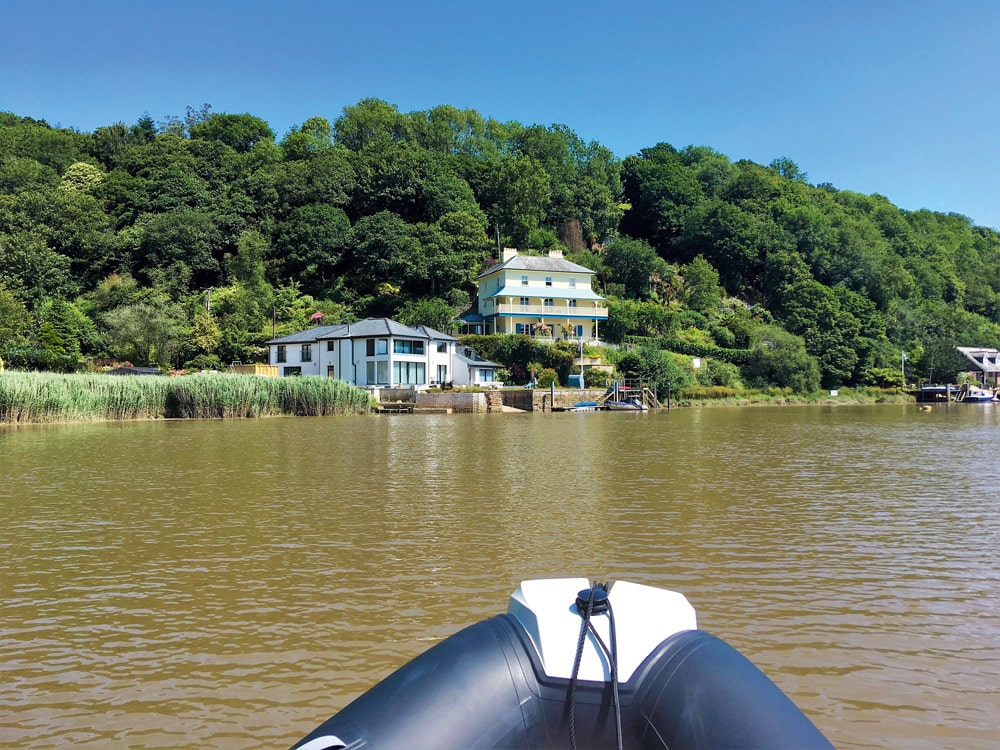
Tamar Calstock approaches
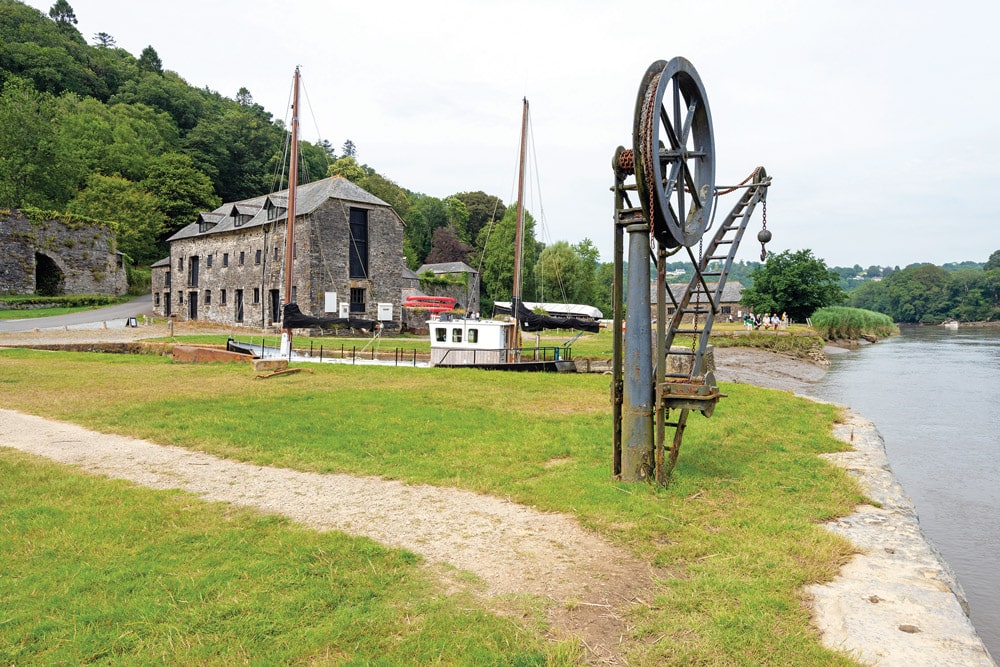
The Discovery centre Cotehele Quay. © Tom Meaker – istock.
Freed at last
St Germans and its mighty viaduct were still so close, but we reckoned a glass of something cold would suit us even better, so we headed back to the marina and the apartment for just that.
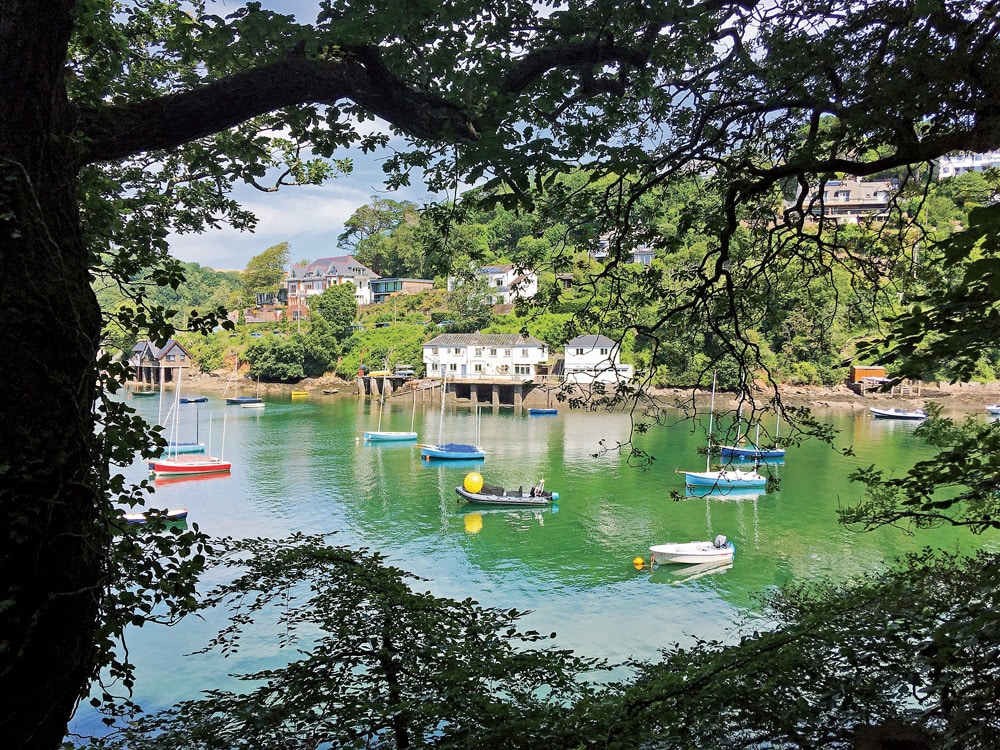
Newton Ferris Noss Creek
We dipped in and out of the practice racing with SailGP but made sure we were on point to watch the final races, which were fast and spectacular with them up on their foils, support boats flashing past and helicopters filming it all. After that, we had one last place to explore:
Newton Ferrers and Noss Mayo.
It was a fast and fabulous journey out of Plymouth past the Mewstone rocks and into the River Yealm. The entrance is straightforward enough, following the leading marks and then channel markers all the way in. At the entrance to Newton Creek, we contacted the harbour master, who pointed out a mooring and gave us the number of the water taxi for a lift to shore. It all went rather well, and we had a lovely amble down Passage Lane to the Ship Inn for some fine riverside views and a lazy lunch. The weather continued to be exquisite, which simply makes day boating the very best, and we had a stroll around Noss Creek, wondering if anyone would remember a rather lonely car parked in the tidal car park.
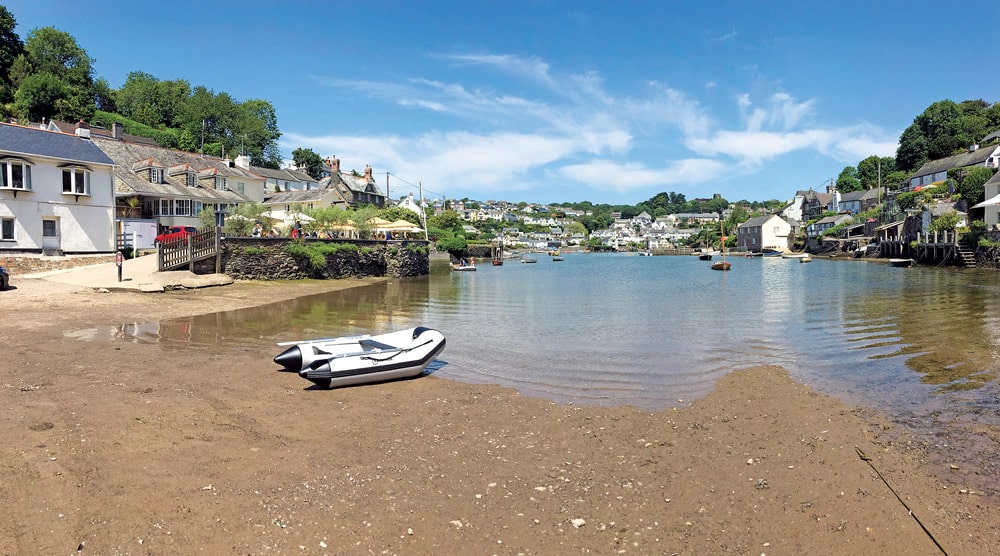
Newton Ferris Noss Creek
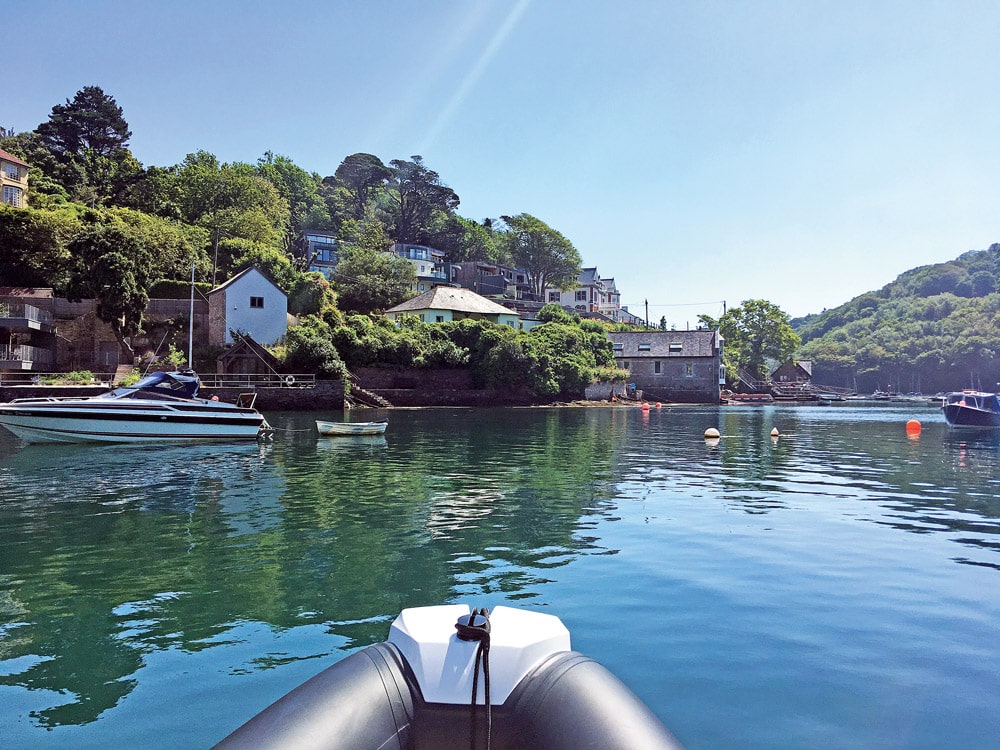
Paradise – Newton Ferrers, Yealm.
The water taxi picked us up and we made our way out of the Yealm. Frankly, the whole holiday in and around the Plymouth area had been one complete highlight for us, but the final trip to Newton Ferrers underlined what a superb area to bring your boat Plymouth Sound is. If you live here, you’ll already know that, but to be honest, the whole of the UK offers up so many places to enjoy your boat. And if it’s on a trailer, it simply makes the business of getting there even easier. Indeed, there is much to be said for setting off down the ‘open road’ – on the trail of adventure!
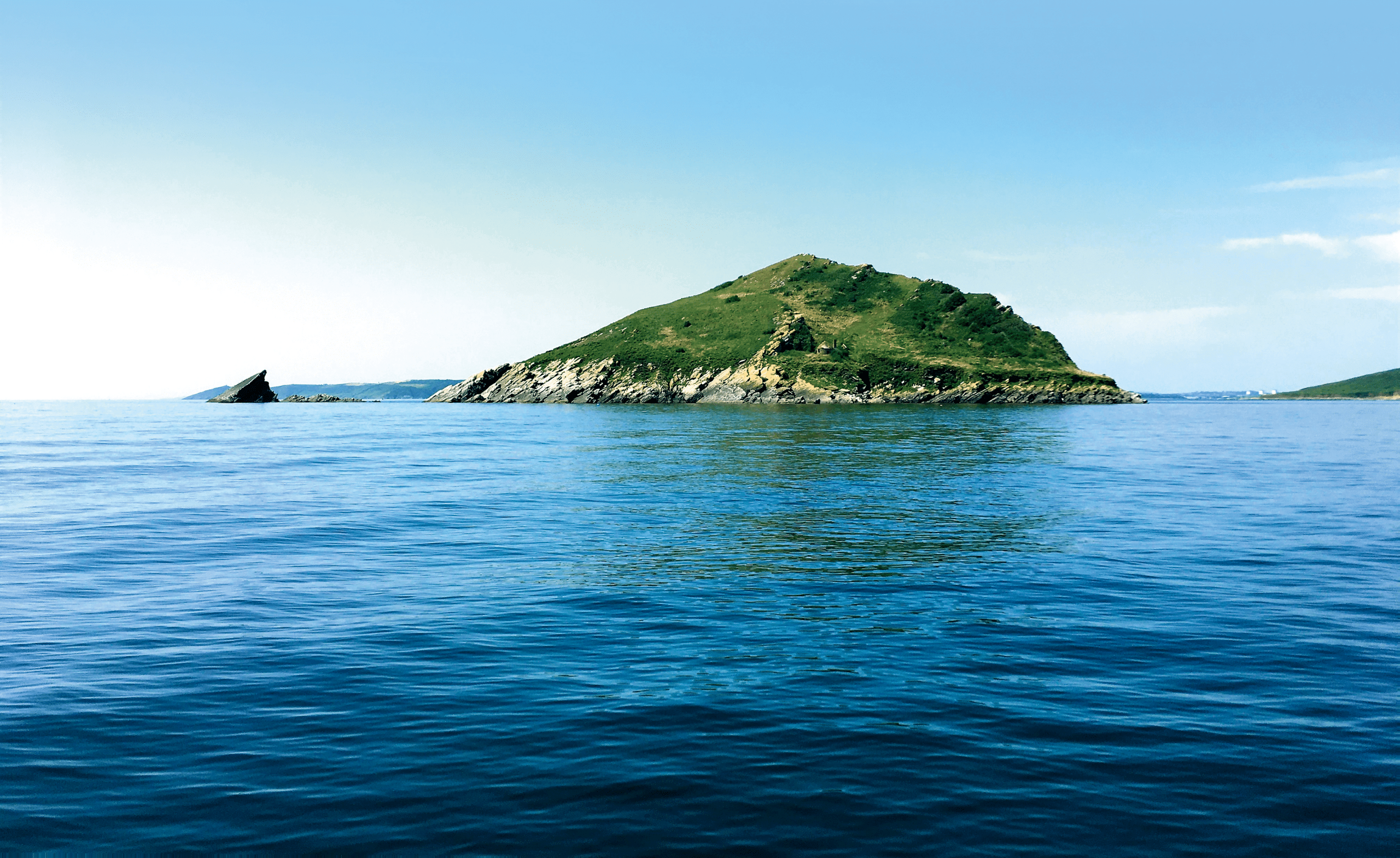
The Mewstone.
Marina facilities
- Royal William Yard: royalwilliamyardapartments.com
- Mayflower Marina: www.mayflowermarina.co.uk
- MDL Queen Anne’s Battery Marina: www.mdlmarinas.co.uk/marinas/mdl-queen-annes-battery
- Yacht Haven Plymouth: www.yachthavens.com/plymouth-yacht-haven
Essential history
The origins of Plymouth date back to Saxon times from when the town firmly established itself as a maritime location. It was where Sir Francis Drake masterminded his defeat of the Spanish Armada in 1588, and where the Pilgrims set off for the New World in 1620, landing first at Cape Cod, then moving across the bay to establish a colony at Plymouth, MA.
Charles Darwin and James Cook are among other famous names from history who used Plymouth as a staging post, and the town was granted city status in 1928. Its naval origins date back to the 17th century when a citadel was constructed on the Hoe (high ground), and dockyards were built over the following 100 years, with the 1-mile breakwater being laid around 1812 to protect the fleet from possible attack by Napoleon’s navy.
The light on the rock
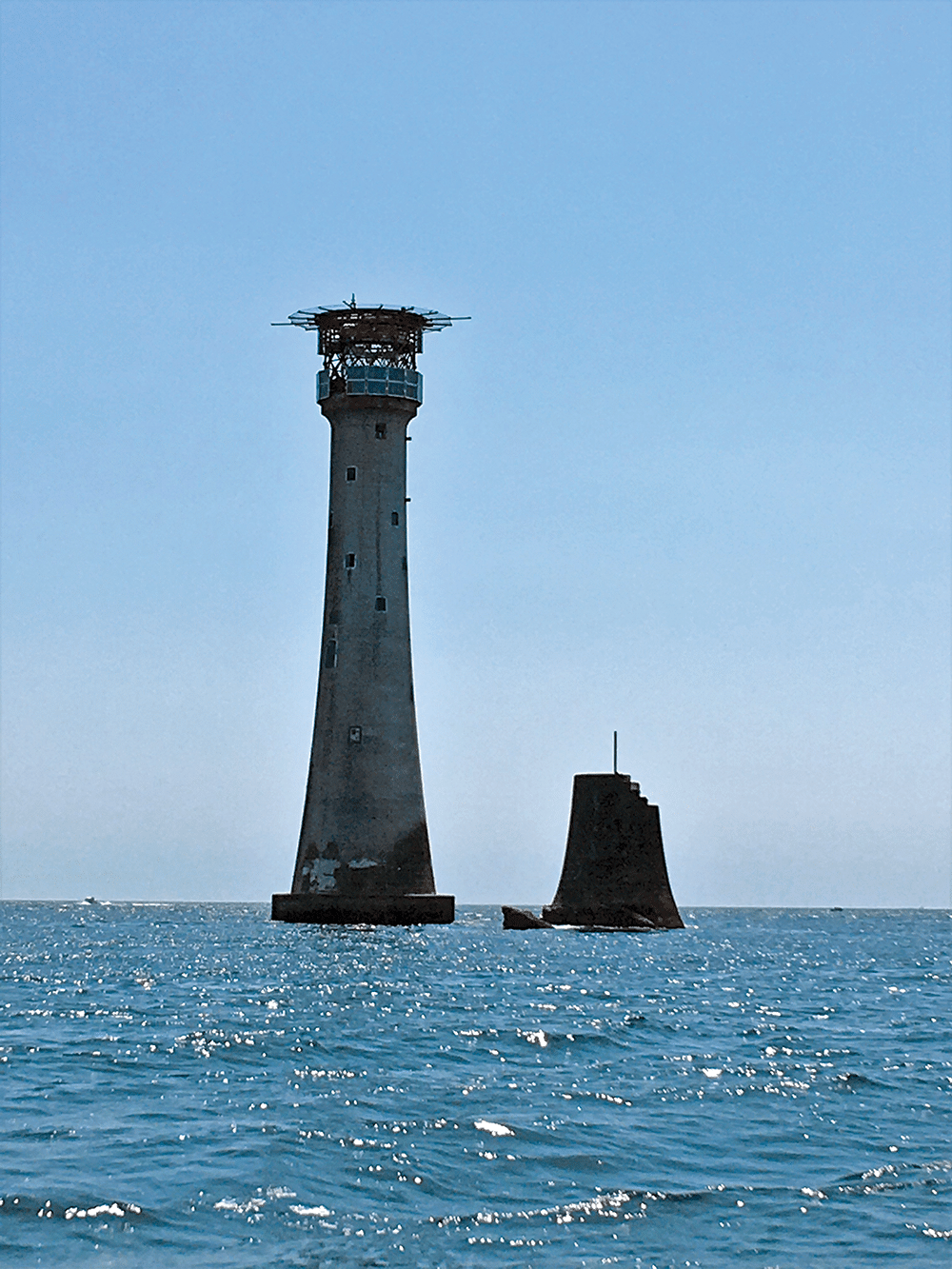
The Eddystone and stump.
Around 12 miles or so south-west of Plymouth Sound stands the Eddystone Lighthouse. The current structure is the fourth to be built on site. The original one, Winstanley’s, was first lit in 1698 but was destroyed during a storm in 1703. The second was designed by John Rudyard and completed in 1709, but it caught fire 46 years later and was again destroyed. John Smeaton took a different approach with his design for the third lighthouse, using new and experimental building methods to complete the structure in 1759. The concept worked, and his structure lasted over a hundred years before erosion to the rocks supporting it meant a fourth lighthouse was needed. This became the current lighthouse built by James Douglass, who used some of Smeaton’s original techniques, which he refined even further over the years. Smeaton’s lighthouse was, however, carefully dismantled and its upper part rebuilt on Plymouth Hoe where it still famously stands on a sea of grass! As for its stump, it sits alongside the Douglass lighthouse, which, we can be all grateful, remains fully functioning to this very day!
Phil & Jules’s biog
Phil and Jules Dargavel started boating together a while back, sailing a Snapdragon 24. Slow and steady, their journeys centred around the Solent with friends and family before starting their own, which placed everything on hold for a while. Since moving to RIBs and power, Christchurch and the Solent still remain their home waters, but they are convinced that owning a trailer-borne craft has broadened their horizons, with adventures already undertaken and plenty more to come.
Useful info
Newton Ferrers, Noss Mayo
You can contact the river authority here via yealmriverauthority.co.uk or by calling them on 01752 872533. The Yealm River Authority website also has a useful Harbour Guide available.
Yealm river hostelries include the Ferryman: Ch69 or 07399 067942; the Ship Inn: 01752 872387, www.nossmayo.com; and the Swan Inn: 01752 873115 www.swaninnnossmayo.com
Royal William Yard
Apartments: www.royalwilliamyardapartments.com
General: www.royalwilliamyard.com
Great resources
We found good old Google Maps to be very helpful, as well as the more specialist information resources like www.boatlaunch.co.uk and www.visitmyharbour.com, and not forgetting www.nationaltrust.org.uk as a useful guide to the many historical houses and sites local to both Plymouth and the upper reaches of the Tamar Estuary and its associated creeks.
Fuel
Mayflower Marina can be contacted via 01752 556633, VHF Channel 80 and/or by email at mayflowermarina.co.uk. Mayflower offers both berthing and trailer storage and serves both fuel and gas. MDL Queen Anne’s Battery also serves dockside petrol and diesel.
Public slipway
This can be found in Richmond Walk, Plymouth, just beyond Mayflower Marina and before Blagdon’s Boatyard. It is an excellent slip, but there is a tight corner at the top for much more than 6m craft. There is limited parking for cars and trailers, and it’s best to use Mayflower Marina next door. MDL Queen Anne’s Battery also has an excellent slip, which is accessible at most states of a neap low-water tide. A fee is charged for using it, though, which is payable at the marina office. A small amount of visitor trailer parking is available here.

